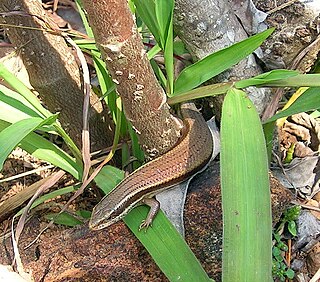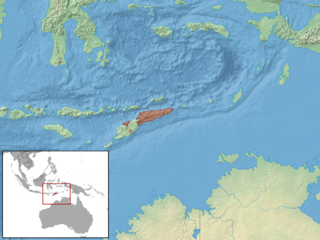
Skinks are lizards belonging to the family Scincidae, a family in the infraorder Scincomorpha. With more than 1,500 described species across 100 different taxonomic genera, the family Scincidae is one of the most diverse families of lizards. Skinks are characterized by their smaller legs in comparison to typical lizards and are found in different habitats except arctic and subarctic regions.

Eremiascincus is a genus of skinks, lizards in the family Scincidae. The genus is endemic to Australia, Indonesia, and East Timor.

Leo Daniel Brongersma was a Dutch zoologist, herpetologist, author, and lecturer.

The Gran Canaria skink is a species of skink in the family Scincidae which is endemic to Gran Canaria. Its natural habitats are temperate forests, temperate shrubland, Mediterranean-type shrubby vegetation, temperate grassland, rocky areas, sandy shores, pastureland, and plantations. The adults measure 16 – 18 cm out of which the tail forms 50%. Their legs are tiny, slim, and have five fingers. They live solitarily and only seek a partner during the mating season. They are ovoviviparous; females give birth to 2 - 4 babies after three months of pregnancy. They are kept as pets in vivariums.
Carinascincus palfreymani, known commonly as the Pedra Branca skink, as well as the Palfreyman's window-eyed skink, the Pedra Branca cool-skink, or the red-throated skink, is a species of skink in the family Scincidae. The species is endemic to Australia, and is restricted to the windswept Pedra Branca, an island off southern Tasmania of only 2.5 ha, where it is dependent on the seabird colonies. It is the only lizard species found on the island.

Lygosominae is the largest subfamily of skinks in the family Scincidae. The subfamily can be divided into a number of genus groups. If the rarely used taxonomic rank of infrafamily is employed, the genus groups would be designated as such, but such a move would require a formal description according to the ICZN standards.

The southern sandslider is a species of skink or Scincidae. The species is endemic to Australia and widespread across the continent, being most commonly found within sandy termite mounds. This is where they take safe refuge from the harsh Australian climate and various ground predators.
Eremiascincus antoniorum is a species of skink, a lizard in the family Scincidae. The species is endemic to Timor in Indonesia.

Eremiascincus brongersmai, also known commonly as Brongersma's tree skink and the brown-sided bar-lipped skink, is a species of lizard in the family Scincidae. The species is endemic to the state of Western Australia.
Eremiascincus butlerorum is a species of skink, a lizard in the family Scincidae. The species is endemic to the island of Sumba in Indonesia.
The orange-sided bar-lipped skink is a species of skink found in the Northern Territory in Australia.
Eremiascincus emigrans is a species of skink found in Indonesia.
The narrow-banded sand-swimmer or thick-tailed skink is a species of skink found in Queensland in Australia.
The northern bar-lipped skink or short-legged slender skink is a species of skink found in the Northern Territory and Western Australia.
The western sand-swimming skink or western narrow-banded skink is a species of skink found in Australia.
The lowlands bar-lipped skink is a species of skink found in Queensland in Australia.
The ghost skink is a species of skink endemic to Australia.

The broad-banded sand-swimmer or Richardson's skink is a species of skink found in Australia.
The rusty skink is a species of skink found in Western Australia.

Eremiascincus timorensis is a species of skink found in Timor in Indonesia.








